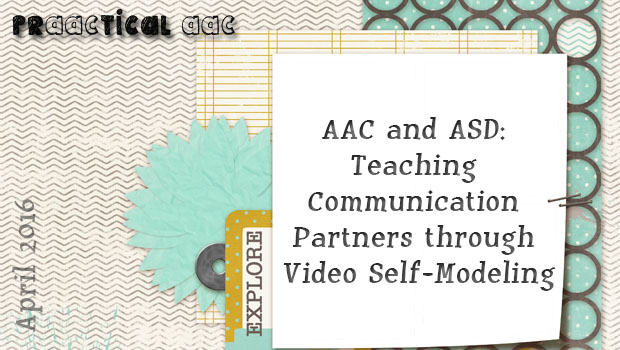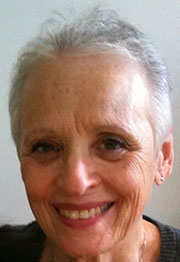AAC and ASD: Teaching Communication Partners through Video Self-Modeling

 It is an honor to have Dr. Joanne Cafiero, an AAC consultant for individuals with complex communication needs and Autism Spectrum Disorders, as a guest contributor for today’s post. Dr. Cafiero is the author of Meaningful Exchanges for People with Autism an Introduction to AAC (2005). She is a consulting editor for Focus on Autism and Other Developmental Disabilities and has guest edited several of ASHA’s Perspectives in AAC. She was a member of the National Academy of Sciences Committee on Educational Interventions for Children with Autism (2001) and is currently working on an update on AAC and Autism for the Academy. In this post, she shares some of her work on video self-modeling.
It is an honor to have Dr. Joanne Cafiero, an AAC consultant for individuals with complex communication needs and Autism Spectrum Disorders, as a guest contributor for today’s post. Dr. Cafiero is the author of Meaningful Exchanges for People with Autism an Introduction to AAC (2005). She is a consulting editor for Focus on Autism and Other Developmental Disabilities and has guest edited several of ASHA’s Perspectives in AAC. She was a member of the National Academy of Sciences Committee on Educational Interventions for Children with Autism (2001) and is currently working on an update on AAC and Autism for the Academy. In this post, she shares some of her work on video self-modeling.
:::::::::::::::::::::::::::::::::::::::::::::::::
Growing research and first-person reports are illuminating the unique sensory and motor differences experienced by people on the Autism Spectrum. This new information has a huge impact on the AAC practitioner. Motor planning differences in ASD can affect consistent and reliable access to AAC. Sensory sensitivities can also have a profound effect on a communication partnership. In the past, an unreliable or contextually irrelevant message would be ignored or documented as a reason for device abandonment. Speaking communication partners now presume the communicative competence of their partner on the Autism Spectrum, respectfully acknowledging each communicative attempt as valid and valuable. This requires the speaking communication partner to have an intimate understanding of the AAC user, as well as AAC partner skills, competence and compassion.
New information about the nature of autism has coincided with validating research for the aided language strategies (Aided Language Stimulation, Aided Language Modeling, Natural Aided Language). From aided language’s humble beginnings in 1992, modeling, acknowledging and expanding using AAC has finally become the standard practice for speaking partners in AAC interventions. This method creates an elegant feedback loop mirroring typical interaction between two speaking communication partners. There are numerous wonderful contributions on aided language right here in PrAACtical AAC.
Teaching Communication Partnerships
If you are a regular reader of PrAACtical AAC, you are on board with all the tenets of aided language. The challenge many practitioners face, however is training others. Some practitioners report that there are new practitioners who exit their university training programs with limited knowledge of AAC, aided language and communication partnerships. Other practitioners struggle with training veteran assistants and teachers who may have to unlearn old habits, are passive partners or who might just be intimidated by AAC. What is the most effective way to train communication partners? This post will describe Video Self-Modeling for the speaking communication partners as an effective way to teach communication partnerships using AAC.
Why Video Self-Modeling?
Video Self-Modeling is a teaching model whereby trainees are shown videotapes of themselves successfully engaging in an activity. It employs the principles of social learning as described by Bandura; we learn most effectively from a model that is similar, but slightly more skilled than ourselves. New mirror neuron theory also supports video self-modeling, in that the neurons that fire when watching a skill are the same neurons, which fire when engaging in the skill, providing a sort of passive rehearsal while watching the video. In this action research project, carefully edited videos produced the perfect and unique teaching model for each trainee. Therefore, watching oneself perform a new task builds self-efficacy and confidence as well as new skill sets.
Video Self-Modeling as Action Research in the Classroom
As a consultant, I knew what to do but often struggled with how to teach others. Inspiring and coercing, of course, were often ineffective. I was also aware that teaching another involves means being in a community of equals where we are learning from each other. I solicited volunteers for communication partnership training from six autism classrooms. Two teachers volunteered themselves and two other teachers asked their paraprofessionals if they were interested in participating. All the paraprofessionals approached were eager to hone their skills in spite of some understandable apprehension about being videotaped.
Action Research Design and Procedures
The research design was a simple A-B, doable in a classroom but not strictly publication quality. As action research the participants were intimately involved in the process. They selected their communication partner, the context or environment and were given communication partner scoring checklists (see below). The scoring checklist describes measurable, observable actions of the speaking communication partner, yielding some quantitative data for measuring progress as objectively as possible.
| 1. | Select, prepare materials/activity | |
| 2. | Get students attention | |
| 3. | Create communication opportunities | |
| 4. | Augment input with AAC | |
| 5. | Use expectant delay | |
| 6. | Model conversationally with AAC | |
| 7. | Acknowledge all relevant communication with AAC | |
| 8. | Acknowledge all irrelevant communication positively asking for more clarification. | |
| 9. | Shape, expand on AAC utterance as model for more complex language | |
| 10. | Withhold target for initial or expanded language | |
| 11. | End on positive note (check affect of both partners). |
This list is not etched in stone; other AAC practitioners may opt for different or more or less expanded and/or detailed criteria.
Communication Partner Trainees
There were 5 trainees participating in this project:
- A 10-year veteran teacher, Lee, wishing to hone his partner skills: He partnered with a 5-year old limited-speaking boy, Joss, who is on the Autism Spectrum. The selected context was playing with wind up toys interactively. Joss and Lee used Proloquo2Go on an I Pad.
- A 15-year veteran paraprofessional, Maryann, recruited by her teacher: She partnered with a 12-year-old limited speaking boy, Charles, on the Autism Spectrum. The selected context was putting together and talking about the photos in a classroom-based yearbook. Maryann and Charles used a low-tech core and fringe communication book.
- A first year teacher, Mindy, who had previously been a paraprofessional: She partnered with a 7-year old boy, Pace, on the Autism Spectrum. Her selected activity was playing with cars and trucks. Pace and Mindy used low-tech activity boards.
- A high school paraprofessional, Steve, with 3 years experience. Steve’s communication partner was a 19-year-old non-speaking young man, Phillip, on the Autism Spectrum. Steve targeted social activities within a structured work environment. Phillip and Steve used an iPad Mini with Proloquo2Go.
- A new, completely untrained paraprofessional, Amanda. Amanda’s communication partner, Annie, 14-years old, loved having her nails painted. Their selected activity was giving and receiving a manicure. Amanda and Annie used activity specific low-tech communication boards.
Week 1
The communication partner checklist was shared in a one on one format with each study participant. Each criterion on the checklist was discussed. Subsequently, each study participant had the opportunity to code a 3-minute, unedited communication partner activity in which I, as the trainer was the speaking communication partner. The purpose of this activity was to “break the apprehension ice” regarding being videotaped. There were numerous places in my sample video that demonstrated less than optimal partnership behaviors. Both illustrative and negative partnership behaviors were discussed, noted on the checklist and a percentage score was calculated.
Week 2
Each communication partner engaged in his or her selected target activity for a 5-minute videotaping. The videotape was coded for the first 3 minutes and a percent-performed score was calculated as baseline for that teacher. This baseline score was not immediately shared with the teacher-trainee.
Week 3
Prior to the week 3 sessions, I viewed each teacher’s videotape and edited out any behavior that did not represent good partnership skills as detailed in the checklist. Each participant had at least one positive behavior, even if it was using time delay. This video represented the first Video Self-Modeling teaching video and the initial discussion topics for that meeting. The participants then had the opportunity to see themselves as competent and effective communication partners from the get go. Needless to say, this curtailed any previous camera shyness.The trainee engaged in the target activity with the AAC user for a 3-minute videotaping (which would be edited for the next week’s session). Other criteria on the checklist were discussed.
Week 4
Prior to Week 4 session, week 3 videotape was coded using the partnership checklist. A teaching video was made by including only those features the teacher-trainee performed that were represented in the checklist criteria. This video was shown to the trainee and the topics of that meeting were the specific positive behaviors demonstrated on the video from the previous week as well as other criteria on the checklist We also reinforced the previous weeks successes by discussing, for example, time delay, or modeling to insure that there would be a cumulative increase in partnership skills. The teacher-trainee engaged in the target activity with the AAC user and the 3rd, 3- minute training video was made.
Week 5
Prior to the week 5 sessions, the week 4 video was edited and coded (now representing many more features on the checklist) and used as a teaching model for this session. The teacher-trainer and trainee viewed this video and coded and scored it using the partnership checklist. The final video was taken and with the teacher-trainee, viewed and coded to show best practices in communication partnerships.
General Results
As an action research study, the results are a promising practice in teaching communication partnership skills using video self-modeling. Overall there was a mean cumulative increase in the implementation of the partnership checklist criteria from 30% to 80%. An additional bonus was the accumulation of enough video footage to create a full 10-minute training video in which the features of good communication partnerships were beautifully modeled by trainees. This video was a powerful peer- model for next-generation communication partners.
Filed under: Featured Posts, PrAACtical Thinking
This post was written by Carole Zangari

1 Comment
What a wonderful and doable description of an implementation strategy that truly builds competence and capacity. Thank you for sharing!!